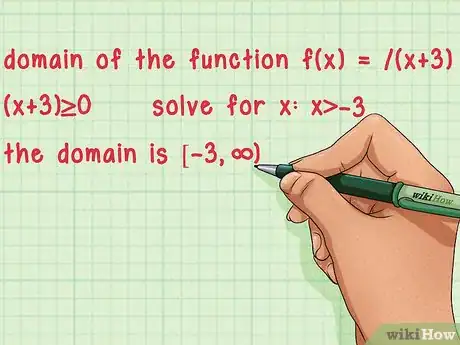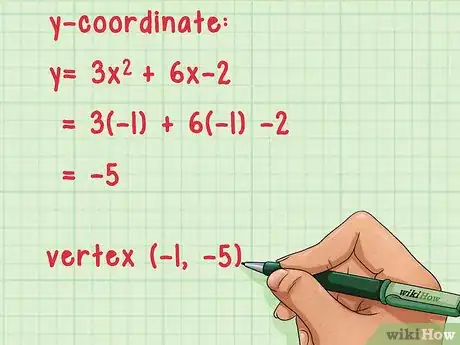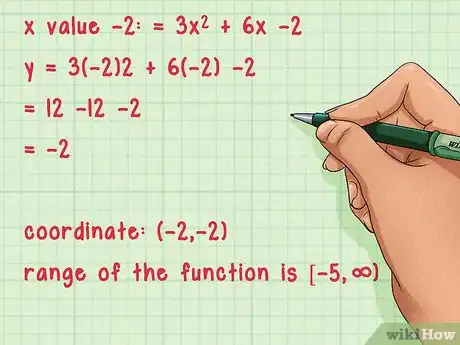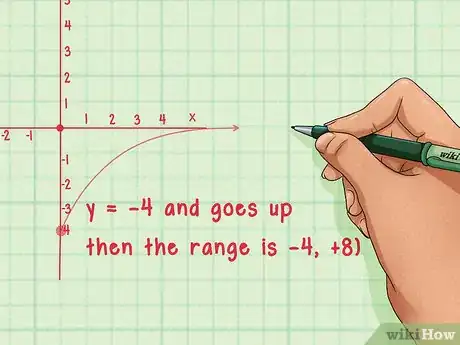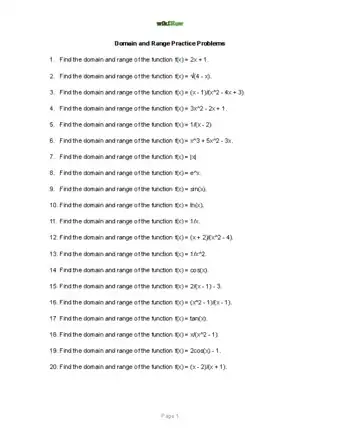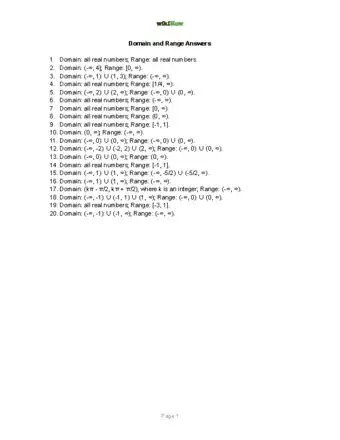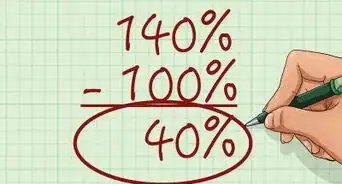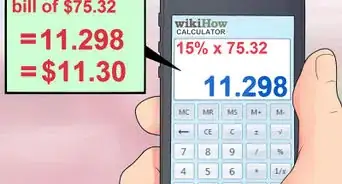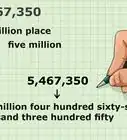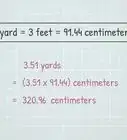This article was co-authored by David Jia. David Jia is an Academic Tutor and the Founder of LA Math Tutoring, a private tutoring company based in Los Angeles, California. With over 10 years of teaching experience, David works with students of all ages and grades in various subjects, as well as college admissions counseling and test preparation for the SAT, ACT, ISEE, and more. After attaining a perfect 800 math score and a 690 English score on the SAT, David was awarded the Dickinson Scholarship from the University of Miami, where he graduated with a Bachelor’s degree in Business Administration. Additionally, David has worked as an instructor for online videos for textbook companies such as Larson Texts, Big Ideas Learning, and Big Ideas Math.
This article has been viewed 231,881 times.
Every function contains two types of variables: independent variables and dependent variables, whose values literally “depend” on the independent variables. For example, in the function y = f(x) = 2x + y, x is independent and y is dependent (in other words, y is a function of x). The valid values for a given independent variable x are collectively called the “domain.” The valid values for a given dependent variable y are collectively called the “range.”[1]
Steps
Finding the Domain of a Function
-
1Determine the type of function you’re working with. The domain of the function is all of the x-values (horizontal axis) that will give you a valid y-value output. The function equation may be quadratic, a fraction, or contain roots. To calculate the domain of the function, you must first evaluate the terms within the equation.[2]
- A quadratic function has the form ax2 + bx + c: f(x) = 2x2 + 3x + 4
- Examples of functions with fractions include: f(x) = (1/x), f(x) = (x + 1)/(x - 1), etc.
- Functions with a root include: f(x) = √x, f(x) = √(x2 + 1), f(x) = √-x, etc.
-
2Write the domain with proper notation. Writing the domain of a function involves the use of both brackets [,] and parentheses (,). You use a bracket when the number is included in the domain and use a parenthesis when the domain does not include the number. The letter U indicates a union that connects parts of a domain that may be separated by a gap.[3]
- For example, a domain of [-2, 10) U (10, 2] includes -2 and 2, but does not include number 10.
- Always use parentheses if you are a using the infinity symbol, ∞. This is because infinity is a concept and not a number.
Advertisement -
3Draw a graph of the quadratic equation. Quadratic equations make a parabolic graph that either points up or down. Given that the parabola will continue infinitely outward on the x-axis, the domain of most quadratic function is all real numbers. Stated another way, a quadratic equation encompasses all of the x-values on the number line, making its domain R (the symbol for all real numbers).[4]
- To get an idea of the function choose any x-value and plug it into the function. Solving the function with this x-value will output a y-value. These x- and y-values are a coordinate (x, y) of the graph of the function.
- Plot this coordinate and repeat the process with another x-value.
- Plotting a few values in this fashion should give you a general idea of shape of the quadratic function.
-
4Set the denominator equal to zero, if it’s a fraction. When working with a fraction, you can never divide by zero. By setting the denominator equal to zero and solving for x, you can calculate the values that will be excluded in the function.[5]
- For example: Identify the domain of the function f(x) = (x + 1)/(x - 1).
- The denominator of this function is (x - 1).
- Set it equal to zero and solve for x: x – 1 = 0, x = 1.
- Write the domain: The domain of this function cannot include 1, but includes all real numbers except 1; therefore, the domain is (-∞, 1) U (1, ∞).
- (-∞, 1) U (1, ∞) can be read as the set of all real numbers excluding 1.The infinity symbol, ∞, represents all real numbers. In this case, all real numbers greater than 1 and less than one are included in the domain.
-
5Set the terms inside the radical to be greater than or equal to zero, if there’s a root function. You cannot take the square root of a negative number; therefore, any x-value that leads to a negative number must be excluded from the domain of that function.[6]
- For example: Identify the domain of the function f(x) = √(x + 3).
- The terms within the radical are (x + 3).
- Set them greater than or equal to zero: (x + 3) ≥ 0.
- Solve for x: x ≥ -3.
- The domain of this function includes all real numbers greater than or equal to -3; therefore, the domain is [-3, ∞).
Finding the Range of a Quadratic Function
-
1Confirm that you have a quadratic function. A quadratic function has the form ax2 + bx + c: f(x) = 2x2 + 3x + 4. The shape of a quadratic function on a graph is parabola pointing up or down. There are different methods to calculating the range of a function depending on the type you are working with.[7]
- The easiest way to identify the range of other functions, such as root and fraction functions, is to draw the graph of the function using a graphing calculator.
-
2Find the x-value of the vertex of the function. The vertex of a quadratic function is the tip of the parabola. Remember, a quadratic equation is of the form ax2 + bx + c. To find the x-coordinate use the equation x = -b/2a. This equation is a derivative of the basic quadratic function which represents the equation with a zero slope (at the vertex of the graph, the slope of the function is zero).[8]
- For example, find the range of 3x2 + 6x -2.
- Calculate x-coordinate of vertex: x = -b/2a = -6/(2*3) = -1
-
3Calculate the y-value of the vertex of the function. Plug the x-coordinate into the function to calculate the corresponding y-value of the vertex. This y-value denotes the edge of your range for the function.[9]
- Calculate y-coordinate: y = 3x2 + 6x – 2 = 3(-1)2 + 6(-1) -2 = -5.
- The vertex of this function is (-1, -5).
-
4Determine the direction of the parabola by plugging in at least one more x-value. Choose any other x-value and plug it into the function to calculate the corresponding y-value. If the y-value is above the vertex, the parabola continues to +∞. If the y-value is below the vertex, the parabola continues to -∞.[10]
- Use the x-value -2: y = 3x2 + 6x – 2 = y = 3(-2)2 + 6(-2) – 2 = 12 -12 -2 = -2.
- This yields the coordinate (-2, -2).
- This coordinate tells you that the parabola continues above the vertex (-1, -5); therefore, the range encompasses all y-values above -5.
- The range of this function is [-5, ∞)
-
5Write the range with proper notation. Like the domain, the range is written with the same notation. Use a bracket when the number is included in the domain and use a parenthesis when the domain does not include the number. The letter U indicates a union that connects parts of a domain that may be separated by a gap.[11]
- For example, a range of [-2, 10) U (10, 2] includes -2 and 2, but does not include number 10.
- Always use parentheses if you are a using the infinity symbol, ∞.
Finding the Range of a Function Graphically
-
1Graph the function. Oftentimes, it is easiest to determine the range of a function by simply graphing it. Many root functions have a range of (-∞, 0] or [0, +∞) because the vertex of the sideways parabola is on the horizontal, x-axis. In this case, the function encompasses all of the positive y-values if the parabola goes up, or all of the negative y-values if the parabola goes down. Fraction functions will have asymptotes that define the range.[12]
- Some root functions will start above or below the x-axis. In this case, the range is determined by the point the root function starts. If the parabola starts at y = -4 and goes up, then the range is [-4, +∞).
- The easiest way to graph a function is to use a graphing program or a graphing calculator.
- If you do not have a graphing calculator, you can draw a rough sketch of a graph by plugging x-values into the function and getting the corresponding y-values. Plot these coordinates on the graph to get an idea of the shape of the graph.
-
2Find the minimum of the function. Once you have graphed the function, you should be able to clearly see the lowest point of the graph. If there is no obvious minimum, know that some functions will continue on to -∞.[13]
- A fraction function will include all points except those at the asymptote. They often have ranges such as (-∞, 6) U (6, ∞).
-
3Determine the maximum of the function. Again, after graphing, you should be able to identify the maximum point of the function. Some functions will continue on to +∞ and therefore, will not have a maximum.[14]
-
4Write the range with proper notation. Like the domain, the range is written with the same notation. Use a bracket when the number is included in the domain and use a parenthesis when the domain does not include the number. The letter U indicates a union that connects parts of a domain that may be separated by a gap.[15]
- For example, a range of [-2, 10) U (10, 2] includes -2 and 2, but does not include number 10.
- Always use parentheses if you are a using the infinity symbol, ∞.
Domain and Range Calculator, Practice Problems, and Answers
Community Q&A
-
QuestionWhat is the domain and range of the function: f(x)=3x-12x+5?
 PimemorizedTop AnswererIf you simplify the function, you can see that it's f(x) = -9x + 5, which is a linear function. Linear functions go infinitely in every direction, and therefore both the domain and the range of the function are negative to positive infinity.
PimemorizedTop AnswererIf you simplify the function, you can see that it's f(x) = -9x + 5, which is a linear function. Linear functions go infinitely in every direction, and therefore both the domain and the range of the function are negative to positive infinity. -
QuestionHow do I find the range of a function without graphing?
 Llp33Community AnswerLooking at a list of ordered pairs (a relation and possibly a function), the y-values (second values) in each ordered pair make up the range. You should list them in order from least to greatest. No graphing is required.
Llp33Community AnswerLooking at a list of ordered pairs (a relation and possibly a function), the y-values (second values) in each ordered pair make up the range. You should list them in order from least to greatest. No graphing is required. -
QuestionHow to find the domain of 1/√x+|x|?
 Community AnswerYou need x to be non-negative in order to be able to compute its square root. X also cannot be zero, or else you will be dividing by zero. Any strictly positive value of x is fine to be in the domain, because both the square root and the division steps are allowed. In interval notation, say the domain of x is (0, infinity).
Community AnswerYou need x to be non-negative in order to be able to compute its square root. X also cannot be zero, or else you will be dividing by zero. Any strictly positive value of x is fine to be in the domain, because both the square root and the division steps are allowed. In interval notation, say the domain of x is (0, infinity).
References
- ↑ http://www.montereyinstitute.org/courses/DevelopmentalMath/COURSE_TEXT2_RESOURCE/U17_L2_T3_text_final.html
- ↑ https://www.cuemath.com/calculus/domain-and-range-of-a-function/
- ↑ http://www.biology.arizona.edu/biomath/tutorials/notation/setbuildernotation.html
- ↑ https://www.cuemath.com/calculus/domain-and-range-of-a-function/
- ↑ http://www.montereyinstitute.org/courses/DevelopmentalMath/COURSE_TEXT2_RESOURCE/U17_L2_T3_text_final.html
- ↑ http://www.montereyinstitute.org/courses/DevelopmentalMath/COURSE_TEXT2_RESOURCE/U17_L2_T3_text_final.html
- ↑ http://www.montereyinstitute.org/courses/DevelopmentalMath/COURSE_TEXT2_RESOURCE/U17_L2_T3_text_final.html
- ↑ https://www.khanacademy.org/math/algebra-home/alg-functions/alg-determining-the-range-of-a-function/a/finding-range-of-quadratic-functions
- ↑ https://www.khanacademy.org/math/algebra-home/alg-functions/alg-determining-the-range-of-a-function/a/finding-range-of-quadratic-functions
- ↑ https://www.khanacademy.org/math/algebra-home/alg-functions/alg-determining-the-range-of-a-function/a/finding-range-of-quadratic-functions
- ↑ http://www.biology.arizona.edu/biomath/tutorials/notation/setbuildernotation.html
- ↑ https://www.khanacademy.org/math/algebra-home/alg-functions/alg-determining-the-range-of-a-function/a/finding-range-of-quadratic-functions
- ↑ https://math.libretexts.org/Courses/Borough_of_Manhattan_Community_College/MAT_206_Precalculus/3%3A_Polynomial_and_Rational_Functions_New/3.2%3A_Quadratic_Functions
- ↑ https://math.libretexts.org/Courses/Borough_of_Manhattan_Community_College/MAT_206_Precalculus/3%3A_Polynomial_and_Rational_Functions_New/3.2%3A_Quadratic_Functions
- ↑ http://www.biology.arizona.edu/biomath/tutorials/notation/setbuildernotation.html
About This Article
The domain of a function is the collection of independent variables of x, and the range is the collection of dependent variables of y. To find the domain of a function, just plug the x-values into the quadratic formula to get the y-output. To find the range of a function, first find the x-value and y-value of the vertex using the formula x = -b/2a. Then, plug that answer into the function to find the range. To properly notate the range, write out the numbers in brackets if they're included in the domain or in parenthesis if they're not included in the domain. To learn how to find the range of a function graphically, read on!




